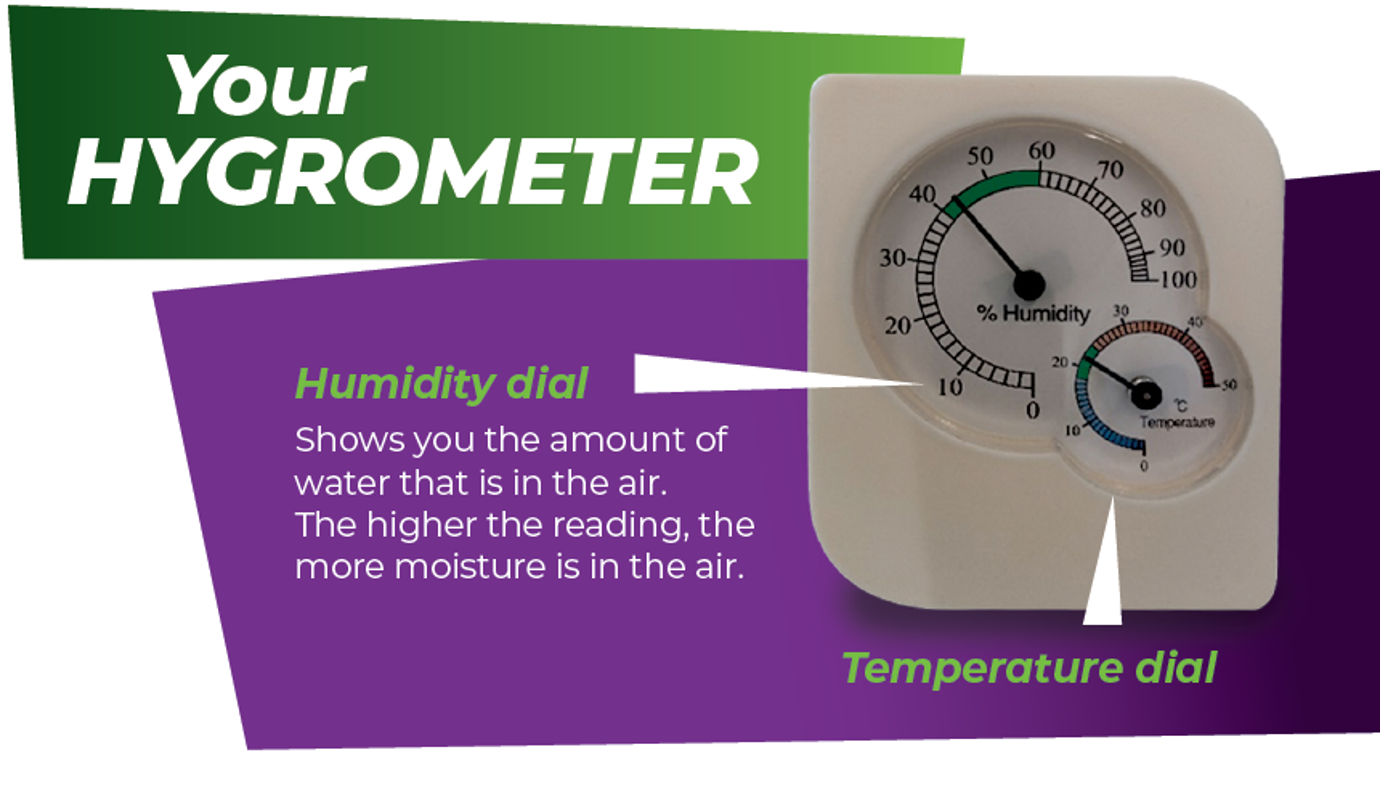Using your hygrometer to help manage condensation
The hygrometer is a useful tool designed to show how much moisture there is inside your home and how warm or cold your property is. Understanding these things can help you to take action to reduce condensation, which can lead to black mould.

Download the hygrometer information leaflet
Frequently asked questions
How can I use the hygrometer to help manage condensation?
Follow the advice on this page to help reduce condensation in your home and do your best to keep the needles on the hygrometer in the green zone on both dials. This will help reduce condensation that can lead to mould.
For maximum comfort levels, the humidity should be between 40% and 60%, and the temperature between 18 and 24 degrees C.
Where should I put the hygrometer in my home?
The ideal place for the hygrometer is a general living area like your lounge or bedroom.
Putting it in your kitchen or bathroom will show large rises and falls in humidity and temperature, for example when you are cooking or using the bath or shower. These won’t give an accurate picture of the moisture in your home.
Condensation
What is condensation and how can it lead to black mould?
Condensation forms when moisture in the air settles as water droplets on a colder surface like a window or wall, or in parts of the home with little space for air to circulate, for example behind furniture.
All homes get condensation on, for example, windows and this isn’t a problem if it clears up quickly. It can be wiped away with a towel and opening a window in the room for around 15 minutes is helpful for ventilation.
Problems begin when water is left on a surface for long enough to start causing damage or mould to grow.
Why do you get condensation in homes?
- High amounts of moisture in the home from everyday activities such as showering, cooking and drying clothes indoors.
- Not enough ventilation in the home to help air circulate.
- Cool temperatures (below 18°C).
Tips to reduce condensation in your home
On dry days open some windows to allow humid air to ventilate out of your home. It is better to open a few windows a little throughout the whole house to help air to move through your home, rather than opening one window wide. Try to do this as often as possible (2-3 times a week), but keep windows closed on wet days as damp air may increase humidity in your home.
Put lids on your pots and pans when you cook. This will also help with reducing energy costs as your food will cook faster.
Keep the doors to the bathroom and kitchen closed when you are bathing or cooking, and afterwards too. Also open the window to allow steam and moisture to escape outside.
Use thermal or lined curtains, keeping them open in the day and closed before dusk. This will capture the free heat from the sun and help to lift the temperature in your home.
On cold days try to keep the temperature in your home to at least 18°C.
Use a towel to wipe up condensation you find on windows. If you don’t, the moisture will collect on the frame which may start to cause damage. The moisture may also evaporate again during the day, raising humidity levels which makes condensation worse when the room cools down.
Limit the number of pot plants in your house. If you start to notice mould or condensation near your house plants, think about moving them to a better ventilated spot or outdoors.
Let air get to the walls. External walls are cooler than internal walls - keep furniture away from external walls to allow air to circulate.
Don’t use a portable gas heater. These create high levels of humidity and are expensive to run. They also release harmful gases into the air.
Where possible, heat as many rooms in your home as possible. This will increase the whole house temperature of your home and make condensation less likely.
Wherever possible, dry your clothes outdoors.
If you do have to dry clothes indoors, use a clothes maiden, and keep the room ventilated when using it. Drying clothes on radiators releases a lot of moisture into the air quickly, creating a high risk of condensation.
Any questions about using your hygrometer?
Please get in touch with us and our team will be happy to help you.
Call 0161 393 7117 or email websiteenquiries@fcho.co.uk
Supporting you
In the colder months, especially when energy prices are high, it may not always be possible to open your windows and let out valuable heat from your home.
We also understand that you may not be able to use your heating for as long or a frequently as you would like.
We’re here to support you and give advice if you are finding it hard to manage energy costs or facing other financial worries.
Get in touch with our Community Services teams and see how we can help you:
Call 0161 393 7117 or email: CommunityServices@fcho.co.uk